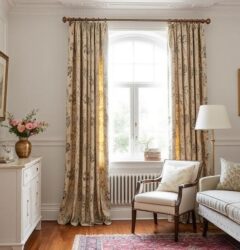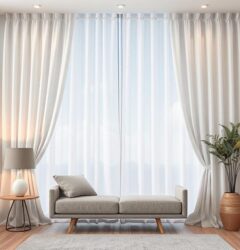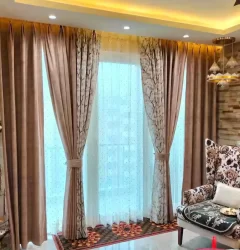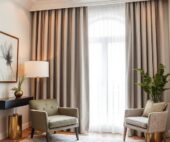**Designs of Curtains:
Curtains are an essential element of interior décor, playing a dual role in enhancing aesthetics and offering functionality such as privacy, light control, and insulation. The design of curtains has evolved over centuries, influenced by cultural trends, fabric innovations, and changing tastes in home décor. Today, curtain designs cater to a wide range of preferences, from minimalist and modern to luxurious and traditional.
One of the primary aspects of curtain design is the choice of **fabric**. Light fabrics like cotton, linen, and sheer voile are popular in contemporary and casual settings, as they allow natural light to filter through while maintaining a sense of openness. On the other hand, heavier fabrics like velvet, brocade, and silk are associated with grandeur and are ideal for formal spaces such as living rooms and master bedrooms. These materials not only add richness but also help in sound dampening and thermal insulation.
**Color and pattern** also play a significant role in curtain design. Neutral and solid colors such as beige, white, gray, and navy are often chosen for a timeless and versatile look. Patterns like florals, stripes, checks, and geometric prints can either subtly blend with the overall décor or act as statement pieces. Floral prints lend a touch of softness and are widely used in classic and country-style interiors. Geometric patterns and bold prints suit modern and eclectic designs.
The **style and cut** of the curtain is another crucial aspect. Common styles include rod-pocket curtains, which have a casing at the top through which the rod is inserted; grommet or eyelet curtains, which feature metal rings for a contemporary look; tab-top curtains, where loops of fabric hang on the rod; and pleated curtains like pinch pleats or box pleats that offer a more tailored and elegant appearance. Each style offers a different drape and ambiance.
Curtains can also be layered to enhance functionality and style. A popular combination is using sheer curtains for daytime privacy and light diffusion, paired with blackout or opaque drapes for nighttime. This layered approach adds depth and texture to the window treatment and allows for flexible light control.
**Curtain accessories** such as tiebacks, valances, pelmets, and tassels can elevate the overall appearance. Tiebacks can be fabric-based or metallic and are used to hold curtains open stylishly. Valances and pelmets are decorative top treatments that conceal curtain rods and add a finished look to the window.
In recent years, **customized curtain designs** have gained popularity. With digital printing and bespoke tailoring, homeowners can now personalize curtains to suit their tastes and the theme of their interiors. Eco-friendly and sustainable fabrics are also emerging trends, reflecting a growing awareness of environmental responsibility.
In conclusion, curtain design is a blend of functionality, fabric selection, color theory, and style preference. Whether aiming for a soft, romantic vibe or a sleek, modern aesthetic, the right curtain design can transform the mood and character of any space.







